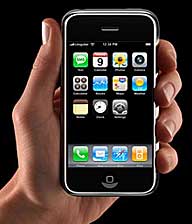Mac Musings
The iPhone: Is It a Macintosh?
Daniel Knight - 2007.03.20
Is the iPhone a Macintosh?
That's a question we've been pondering here at Low End Mac, because our primary focus is the Macintosh. Not iPods. Not Apple TV. Not Apple displays or printers.
Yes, we do look at the iPod now and again. We have a couple at LEM headquarters - a 1G model recently upgraded with a 20 GB drive after the original 10 GB drive failed and a 60 GB iPod photo. They're great for backing up our work - and also good for listening to music.
We cover all the Mac clones, because they do run the Mac OS - and it's the Mac OS that makes a Mac a Mac.
We have profiles of Lisa, the Mac's mother. And we have profiles of NeXT computers, not because they're Macs, but because they ran NeXTstep, the predecessor to OS X.
 But where does the iPhone fit into
the picture? Is it a glorified iPod? Or does the fact that it runs
OS X make it a Mac?
But where does the iPhone fit into
the picture? Is it a glorified iPod? Or does the fact that it runs
OS X make it a Mac?
It's Not a Mac
The iPhone is a closed box, like the iPod. There's nowhere to plug in extra memory, let alone connect a keyboard and mouse.
It doesn't have a Motorola 680x0, PowerPC, or Intel Core processor inside, which means it has a completely different hardware architecture than any Mac or clone.
The 320 x 480 screen is tiny compared to any modern Mac. In fact, it has a lower resolution than the 512 x 342 of the original Macintosh. (Okay, we'll admit that it's not that much lower than the original Mac, but we also have to note that Mac OS X feels very constricted on an 800 x 600 display.)
And finally, it runs a custom version of OS X. Apple very deliberately doesn't call it Mac OS X.
It Is a Mac
Ah, but there's the rub. It does run OS X, even if it is a different version than you have on your Mac.
The iPhone has the same OS underpinnings as your Mac, but compiled for a different CPU (Apple hasn't yet stated which one) and optimized for a completely different environment. And it has support for a lot of neat new technology, including a virtual keyboard, automatic orientation detection, and a touch screen that supports two-finger actions.
I can't imagine any of those features not making it into a MacTablet, should Apple ever release such a device.
And it really doesn't matter that the iPhone has a completely different CPU than any previous Mac. The same could be said of the first PowerPC and Intel Macs. Hardware isn't what makes a Mac a Mac - the operating system it.
The Closed Box
There is one place where the iPhone is different from any Mac, past or present. There's no third-party software for it. Yet. And when it does come, it will probably be controlled by Apple.
There doesn't seem to be a mechanism for installing software on the iPhone by downloading it from the Internet. At this time, it appears that you'll only be able to buy iPhone software from Apple, and they'll handle loading it on your iPhone.
Given time, I'm sure that will change. Someone will figure out how to install software on the iPhone's flash drive. But until then, the iPhone is the most closed computer Apple has ever built.
In the end, that (being a computer) is what makes the iPhone a Mac. It's a new form factor for a personal computer, and it runs a version of the Mac's operating system.
What that means for us is that the iPhone fits into Low End Mac's primary focus: The Macintosh computing experience. Expect to read a lot more about the iPhone once Apple releases more details and people get their hands on the newest Mac.
Join us on Facebook, follow us on Twitter or Google+, or subscribe to our RSS news feed
Dan Knight has been using Macs since 1986, sold Macs for several years, supported them for many more years, and has been publishing Low End Mac since April 1997. If you find Dan's articles helpful, please consider making a donation to his tip jar.
Links for the Day
- Mac of the Day: Macintosh 128K, introduced 1984.01.24. 1984 wasn't going to be anything like 1984 thanks to the original Macintosh.